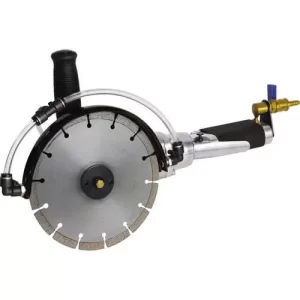Air saws, as their name suggests, are powerful tools that use compressed air to cut. There are many types of saws but air saws have become a favorite in many industries due to their lightweight, versatility, and efficiency. Their precision and ease of use put them among the must-have tools for handymen and DIYers because those attributes simplify tasks that would otherwise require substantial effort and skill.
How Air Saws Work
A traditional saw, often referred to as a conventional saw, operates on a simple principle. It consists of a blade with a serrated edge that is manually moved back and forth to cut through material. The teeth on the blade are designed to remove material on the push, pull, or both movements, depending on the configuration of the saw.
An air saw, on the other hand, uses air from an air compressor to cut through materials. Typically, the compressed air is directed to a pneumatic motor which converts the air pressure into movement. This movement drives the blade of the saw, empowering it to cut through materials efficiently.
Unlike a traditional saw, this process requires less manual labor and provides more accuracy, making air saws a preferred tool for many professionals and DIY enthusiasts.
Types of Air saws
Reciprocating Air Saw
The Reciprocating Air Saw cuts but doing a back-and-forth, or reciprocating, motion. At the “heart” of this tool is the pneumatic motor, a marvel of engineering that breathes life into the saw.
When compressed air is introduced into the saw, it sets the reciprocating motor in motion, and this kinetic energy is transferred to the saw blade, causing it to move swiftly back and forth. It’s this movement of the saw blade that cuts.
Circular Saws
Circular Saws operate on a similar principle as Reciprocating Air Saws but with a key difference in the motion of the blade. Instead of moving back and forth, the blade of a Circular Air Saw rotates at a high speed, powered by the pneumatic motor.
When the compressed air is introduced, it sets the motor in motion, which in turn spins the circular blade. The edges of the circular saw blade have teeth designed to cut through the material as it spins, making it highly efficient for straight cuts.
This rapid rotation enables the circular saw to cut through a variety of materials, including wood, metal, and plastic, with great precision and speed. The circular motion of the blade also allows for a cleaner cut, making it a favorite tool among professionals requiring clean, straight cuts.
Air Band Saw
Air Band Saws are another important type within the family of air saws. Powered by pneumatic energy, the Air Band Saw operates by driving a continuous band of toothed metal, the blade, in a consistent downward motion. Unlike the back-and-forth motion of the reciprocating saw or the high-speed rotation of the circular saw, the Air Band Saw offers smooth and uniform cutting action.
The pneumatic motor propels the band saw blade in a downward loop. The teeth of the blade are designed to cut through materials as the blade moves, making it efficient for precision cuts and also for cutting irregular or curved shapes.
Air Band Saws are often used in metalwork and woodworking due to their versatility and precision. Their ability to produce intricate cuts and shapes makes them a preferred tool for many professionals who require a high degree of accuracy in their work.
Air Jig Saw
Then, there’s the air jigsaw, which works through a combination of pendulum and circular motion. The oscillating movement of the saw’s blade allows it to make quick back-and-forth cuts, while the circular motion enables it to cut through materials with ease.
Due to its flexible nature, the air jigsaw is widely used for cutting curves and irregular shapes in various materials such as wood, metal, and plastic. Its small size and lightweight design make it a convenient tool for cutting in tight spaces or overhead.
Air Hacksaw
Last, but not least in the family of air saws, is the air hacksaw. This type of saw utilizes a reciprocating motion, similar to that of a hand-held hacksaw but with the added power and speed from pneumatic energy. The air hacksaw is designed to make precise and clean cuts through metal materials such as pipes and rods.
The air hacksaw is important when it comes to cutting pipes and tubes. Its thin, fine-toothed blade cuts through metal smoothly, making it an excellent tool for plumbing or HVAC work. I appreciate the control and accuracy it provides, especially when cutting through tough materials.
Benefits of Using Air Saws

Precise Cutting
Air saws offer incredibly precise cutting capabilities. Precision is invaluable when it comes to ensuring that every cut is clean and accurate, making it an essential tool in the workshop.
Minimal Vibration
While working with traditional power saws, you would frequently experience intense vibrations that make it difficult to maintain control over the tool. However, using air saws, especially the modern ones, will make you notice a significant reduction in these troubling vibrations.
This reduction will not only improve the quality of your work but will also decrease the stress on your hands and arms during the operation.
Reduced Operator Fatigue
Another crucial perk is how the use of air saws reduces operator fatigue. When using conventional power saws, you will often find yourself exhausted after just a few hours of work. But with air saws, you will be able to work for longer periods without feeling fatigued, a factor that will boost your productivity immensely.
Versatility
Air saws can be used in a lot of applications. This is possible because, for most of them, you can change the blade. Whether it’s cutting through plastic, wood, or even metal, air saws deliver excellent performance. The wide range of materials these tools can cut enables users to broaden the scope of their work, bringing a newfound versatility to your projects.
What To Consider When Choosing The Right Air saw
Power Source
The first factor to consider is the source of power. It’s important to understand that air saws can be either electric or battery-operated. Electric models, while often offering high performance, require a constant connection to a power outlet which can limit mobility.
On the other hand, battery-operated air saws offer the convenience of cordless operation, but may not operate for many hours as they’ll go off when the battery is drained.
Speed and Power
It’s also important to consider the speed and power of the air saw. These two factors directly impact the saw’s cutting ability and efficiency. For tasks that require more power, such as cutting through metal or thick wood, a higher-powered air saw with variable speed control would be the best choice.
On the other hand, for lighter tasks like shaping plastic or thin wood, a lower-powered air saw would suffice and offer greater precision and control.
Ergonomics
Lastly, ergonomics should also be considered when choosing the right air saw. This includes factors such as weight, grip, and balance of the tool. A lightweight and well-balanced air saw can greatly reduce fatigue during prolonged use, making it easier to achieve accuracy and efficiency in your work.
Additionally, a comfortable grip is essential for maintaining control over the tool and reducing strain on your hands while using it.
Maintenance and Safety care
Regular Inspection
As is the case with most tools, you should regularly check to see if there are any developments on the air saw. These checks allow you to spot any signs of wear, damage, or malfunction early on, permitting timely repairs.
Ideally, Look out for any unusual sounds, leaks, or changes in operational efficiency. Consistent vigilance in this manner helps maintain the longevity of your equipment and ensures that minor issues don’t escalate into major problems.
Adherence to Manufacturer’s Guidelines
Most air tools come with a manual on how to set them up, use, and maintain them. Strive to always adhere to the manufacturer’s guidelines. These instructions provide invaluable insights into the optimal conditions for operating and maintaining the equipment.
They also detail the specific maintenance procedures, ideal operating temperatures, and the recommended schedule for parts replacement. What’s more? These guidelines often contain troubleshooting tips for common problems, making them an essential resource in the maintenance toolkit.
Safety Measures
Safety is paramount when using these machines. Always use the necessary personal protective equipment (PPE) during maintenance and operation to avoid any accidents or injuries.
While at that, make sure the workspace is clean and free from any potential hazards. This approach not only protects you but also extends the lifespan of the equipment by preventing unnecessary damage.
Conclusion
In conclusion, air saws are versatile and powerful tools, valuable in many professional and DIY projects. They come in a variety of types, each with its unique capabilities and suitable applications, making it essential to choose the right one for your needs. The use of air saws isn’t without its responsibilities, though.
Their regular inspections allow early detection of any issues, while adherence to manufacturer guidelines ensures optimal functioning and longevity. Safety, above all else, is paramount, necessitating the use of personal protective equipment and a clean, hazard-free workspace. With the correct selection, proper use, and diligent maintenance, air saws can be a reliable partner in your mechanical pursuits.

